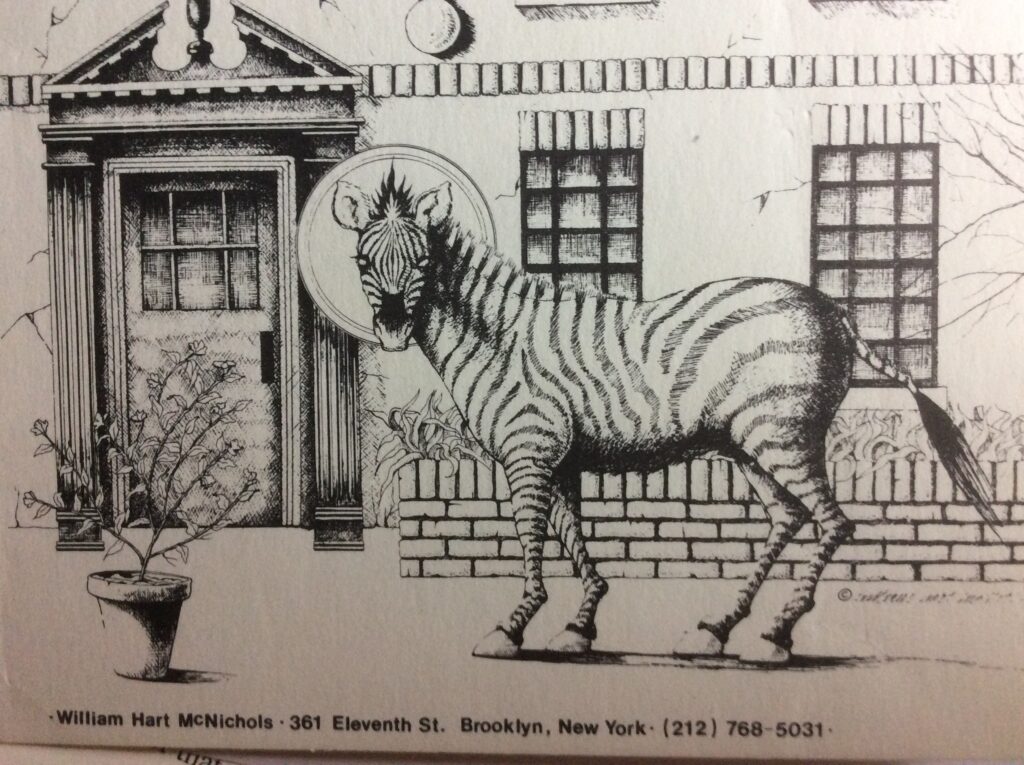I just wanted her to know that maybe someone out there understood. …I wonder if there’s more to this story. Memories that I thought were behind me keep flooding back, and my gut tells me there’s more to her death than what’s been in the news.
Simon Kent Fung, from the podcast “Dear Alana”
Nothing’s gonna harm you / Not while I’m around / …Demons are prowling everywhere, nowadays / I’ll send ‘em howling / I don’t care, I got ways / …No one’s gonna hurt you / No one’s gonna dare / Others can desert you, not to worry / Whistle, I’ll be there / Demons’ll charm you with a smile, for a while / But in time, nothing can harm you / Not while I’m around.
Stephen Sondheim, “Not While I’m Around” from Sweeney Todd: The Demon Barber of Fleet Street
Father, forgive them, they know not what they do.
Luke 23:34
Author’s note: The following is taken from a conversation with my friend Christopher Pramuk, an author and theologian at Regis University.
In George Bernard Shaw’s play “Saint Joan,” Bishop Pierre Cauchon of Beauvais, who is responsible for Joan’s brutal death, comes to a kind of painful conversion. To another character, who watches Joan burn, the bishop says, “Were not the sufferings of Our Lord Jesus Christ enough for you? …Must then a Christ perish in torment in every age to save those who have no imagination?”
It is Shaw’s incredible genius that the key indictment of those who killed Joan is a lack of imagination. Once our imagination is truly touched by the life of Christ, it is no stretch to say that anyone targeted for who they are becomes a Christ figure.
When I was a high school art teacher, I always took my students to the Denver Zoo, because I wanted them to see the infinite imagination of God’s creativity. At the time, I was fascinated by zebras because they have no practical use, like a horse does, for example. Zebras are just beautiful and no two have the exact same pattern of stripes. If I had any gifts as an astronomer, I’d have taken my students to the planetarium, which is equally astounding.

The limitless creativity of God in fashioning human beings is no different. But if you lack imagination, then it’s almost hopeless to make this connection. It then takes a tragedy like that of Joan of Arc, Elijah McClain, Matthew Shepard or Alana Chen, a young LGBTQ woman who died by suicide in 2019, to open your eyes.
Much later, I would learn about the Native American concept of gay persons and their ancient understanding of two-spirit people that came long before Freud. They understood these people were specifically made, set apart by the Great Spirit to serve the whole tribe as spiritual leaders, healers, artists and so on. In my younger years, I was incredibly relieved to find a culture that highly valued and venerated the infinite variety of the Great Spirit’s creation.
In fact, the church is considering Nicholas Black Elk, the Lakota Sioux medicine man and Catholic catechist, for canonization. Along with the sainthood of Kateri Tekakwitha, this would have been unthinkable in my childhood. When I served for eight months at Taos Pueblo, the ancient homeland of the Puebloan people in modern-day New Mexico, people told me, “We have our Indian ways and our Catholic faith. We have woven them together.”
When I read the many articles about Alana Chen, who reportedly underwent conversion therapy to change her sexuality, I knew I had to paint her image. (Images or paintings are different from icons.) I couldn’t allow myself to finish the whole podcast, because I knew I’d break down and never paint her image. I did read articles about her, and my first reaction was so much anger I couldn’t even begin drawing. That passed and then the grief came. I cried for her and her family. I cried many tears remembering my 19-year-old self.
Being so young, and trusting completely in God, I thought, well, I’ll do it. If God wants to change me, then I’m willing.
In 1968, I entered the seminary in Florissant, Mo. This was before the Stonewall riots and any positive talk about same-sex attraction. In those days, you were called, in a derogatory sense, “queer” or “homo.” So, very hesitantly and with fear and trembling, I came out to my novice master. He asked if I’d like to see a psychologist at Saint Louis University. I said yes and began therapy sessions with a psychologist, whom I did not know was a behaviorist.
This doctor was not religious. Following an aversion therapy model, his sole intent was to change my sexuality. He did not confuse my mind with a dangerous view of God, a God whom you can never please—our contemporary form of Jansenism.
Without going into the gory details, I submitted to hypnosis and nausea-inducing therapy. Funnily, the only nausea I experienced was walking into that building every week! That approach didn’t work, so he asked me to try shock therapy. Again, I had to get permission from my novice master, and he left the decision up to me. Being so young, and trusting completely in God, I thought, well, I’ll do it. If God wants to change me, then I’m willing.
In my first session, the doctor attached electrodes to my ankles and administered 75 to 110-volt shocks. When I went home, I put a sock on my door handle—which was understood by everyone in the community to mean DO NOT DISTURB UNLESS EXTREME EMERGENCY—and went to sleep for hours and hours. The next session he only gave me 45-volt shocks and then stopped, utterly dismayed and incredulous. He said something I’ll never forget: “You have the strongest resistance to pain I’ve ever seen in my life.”
Something clicked inside me. For the first time in my life, I was recognized as stronger than anyone. Hey, the highly-educated doctor said so! I told an older priest mentor about the aversion therapy and he exploded with anger. “Billy, why in the world are you letting someone abuse you? God made you this way and you’re never going back to that doctor again!” So, I quit the therapy, and for an entire summer I was asexual, or sexless. Until one day, I was walking with other novices downtown when a beautiful young man passed by and glanced kindly at me. “Damn, it’s back!” I said to myself.
If a person is obsessed with your sexuality, immediately turn and run away.
Later on, that same mentor explained to me that a person’s sexuality is connected to everything: your art, your creativity, your charisma, your élan vital. Think of President Kennedy or Princess Diana, who visibly glowed with that life force. When I met Pope St. John Paul II, once an actor and playwright, he absolutely glowed with spiritual and artistic charisma.
After more than 50 years in religious life and 44 years as a Catholic priest, I’d like to warn young people today that I can count on one hand the number of “authentically straight” people who, in my experience, care about LGBTQ issues. Many of these people do care, however, about the huge issues we are facing right now. Are we going to destroy Mother Earth? Are we going to blow ourselves up?
If a person is obsessed with your sexuality, immediately turn and run away. There’s a good chance they are hiding something and projecting onto you their own self-hatred. I have met so many people who, because they are afraid to be themselves, have created an alter-ego. You can feel and often see it a million miles away—in their behavior, their dress, their elite gnostic spirituality.
In my early 20s, before I became a high school teacher, I took education classes. My teacher said something I’ll never forget. “You will never understand the United States until you read Nathaniel Hawthorne’s masterpiece, The Scarlet Letter,” she said. In Hawthorne’s story, the “pure” Christians—those looking for a smaller, purified church—keep getting more exclusive until all the sinners are ousted, and the accused heroine of the book seems to be the only Christian left. Her intense suffering and imposed isolation have made her a timeless, humble and humiliated Christ figure.
Who better than Our Lady of Sorrows to reach down to catch Alana and bring her home?
When I imagined painting Alana, I had to ask, who is she with now? I thought of Saint Thérèse, one of her favorite saints, but then I realized we were in the season of the wounds, the season of Saints Francis and Padre Pio. We were also in the the season of Our Lady of Sorrows. Who better than Our Lady of Sorrows to reach down to catch Alana and bring her home?
The colors for the image came naturally: her salmon-colored blouse; the vivid blue background, similar to the deep Colorado sky; the purple border and the “Hildegardian” green letters, suggesting the greening of the earth. As I painted, I listened to Saint Hildegard’s haunting chant, “O rubor sanguinis,” and then I turned to Giovanni Pergolesi, a musical genius who died at 26, and his masterpiece, “Stabat Mater.”
I have a writer friend, Sandi Gold, who just finished a book coming out in December. After I sent her two articles about Alana, she texted me, “I wish she had met you.” Through the process of creating this image, I think I have met at least some of Alana, and spoken with her during the weeks I was painting. A final prayer:
Dear Alana, I do wish I’d met you,
and I hope you like your image.
I’m asking that you be another Guardian Angel to me
until we meet and are all together with
God, Our Loving Father, with Jesus Christ, Our Savior and Beloved,
the Holy Spirit who is the author of every true image or icon,
and with Our Blessed Mother, for the meantime … Our Lady of Sorrows.



